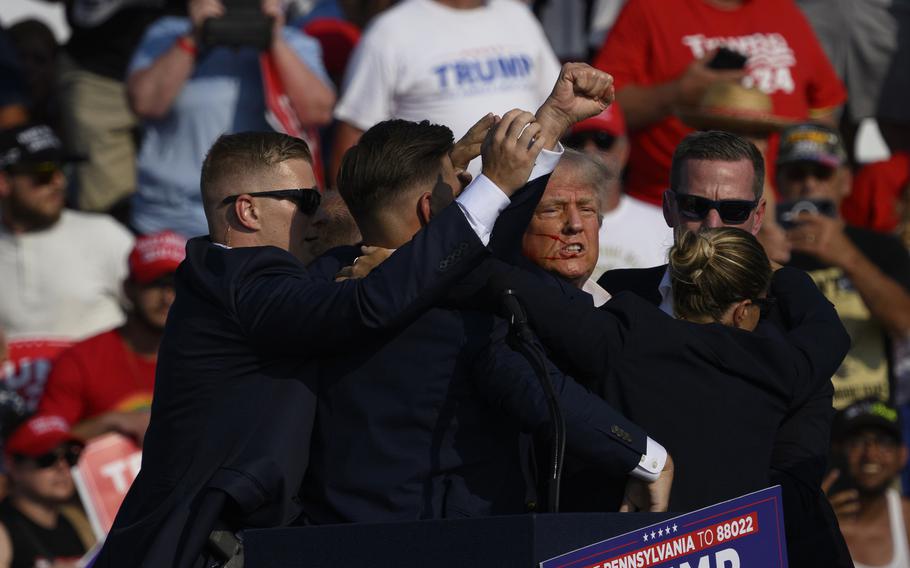
Former president Donald Trump is whisked away by Secret Service after shots rang out at a campaign rally on July 13, 2024, in Butler, Pa. (Jeff Swensen, Getty Images/TNS)
Political assassination is a particularly grim, disturbing and important subject. Murder alone is awful, but violence against a political leader tears at the very fabric and foundations of our system of government.
Unfortunately, this phenomenon has been a regular — though not frequent — occurrence in U.S. political history.
Former President Donald Trump fortunately has survived this latest instance of a despicable crime. His actions have been heroic. He demonstrated self-control under fire, reacted fast and effectively in taking cover, did not panic, and he encouraged others.
The U.S. Secret Service is an exceptionally professional organization, demonstrated dramatically. Agents immediately shielded Trump, others scanned the crowd. The former president was quickly evacuated.
Let’s wait for confirmed facts on exactly what happened. Ignore judgmental largely worthless media speculation.
Tragically, gunfire also struck audience members at the political rally. Former fire chief Corey Comperatore was shielding his family when killed. Two other audience members were wounded.
Unfortunately our nation has a history of such violence. The first attack on an American president took place nearly two centuries ago. An unemployed house painter ambushed President Andrew Jackson in the U.S. Capitol. Fortunately, the would-be killer’s pistols misfired.
Despite age and ill health, Jackson attacked the gunman, who was tackled by others. Jackson survived numerous military battles and also duels with firearms.
During the same general time period, in May 1812, Britain’s Prime Minister Spencer Percival was assassinated. Later, a radical plot to murder Prime Minister Lord Liverpool and his Cabinet in 1820 failed and the conspirators hanged.
Generally, in the decades since, our close ally Britain has been spared this sort of political violence.
President Abraham Lincoln was assassinated on April 14, 1865, while he and his wife and guests were attending a stage play in Washington. The assassin was part of a larger conspiracy to kill senior officials of the Lincoln administration.
A special military commission sentenced four of the conspirators to death by hanging, including Mary Surratt, who managed a boarding house where the Confederate underground met. She became the first woman known to be executed in the United States.
Lone killers assassinated Presidents James Garfield in 1881 and William McKinley in 1901.
Former President Theodore Roosevelt was shot in the chest in 1912 while campaigning in Milwaukee. He completed his speech before being rushed to the hospital, and survived.
Mayor Anton Cermak of Chicago was shot and killed in February 1933 in Miami while in the company of President-Elect Franklin D. Roosevelt. FDR is presumed to have been the actual target.
On Nov. 1, 1950, two Puerto Rico nationalists tried but failed to assassinate President Harry Truman in Washington.
President John F. Kennedy was shot and killed in Dallas on Nov. 22, 1963. Alleged assassin Lee Harvey Oswald was murdered in police custody two days later. That, combined with other circumstances, fueled conspiracy theories which have endured, powerfully.
In 1972, Gov. George Wallace of Alabama, who was seeking the Democratic presidential nomination, was shot and paralyzed while campaigning.
Two women fired pistols at President Gerald Ford, on separate occasions. Both missed.
In early 1981, newly inaugurated President Ronald Reagan was shot and seriously wounded while entering his limousine in Washington after a speech. He survived the ordeal, and in fact his bravery and humor while being treated in the hospital earned him considerable respect.
Presidents’ attackers usually act alone.
Such attacks are sick, as President Joe Biden observed, but do not indicate a sick society or signal political crisis. To reiterate, focus on the facts, not judgmental media speculation.
Ideally, this latest incident fosters rhetorical restraint. Politicians should turn down the heat.
This history is grim but also shows the enduring strength of our political institutions.
Arthur I. Cyr is author of “After the Cold War.”